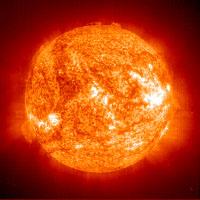NASA in search of the secrets of the Sun
The first of them was planned to be spaced tomorrow: HESSI satellite (High Energy Solar Spectroscopic Imager). But last week's failure in the test with the X-43A plane has caused the launch to delay to July 12, as both used Pegasus rockets in the first stage.

The mission of the HESSI satellite is to analyze by x-ray the explosions that occur in the atmosphere of the Sun. To do this it will orbit around the Earth at 600 km of altitude and 38 ° with respect to the equator. The satellite will jointly collect data on the location of the explosion and the energy content of the radiation. This will predict when the explosions will occur and their effect on Earth. In fact, the radiation emitted by explosions often reaches the Earth, which affects satellites, media and astronaut health.
On the other hand, on July 30, the Genesis probe is projected to be directed towards the Sun, although the launch was originally scheduled for January 2001. Private companies and laboratories have also participated in Gene sis in order to better understand the composition of the Sun.
The mission of the probe is to collect and bring to Earth samples of oxygen, nitrogen, noble gases and other elements present in the solar wind. It has a special silicon collector in a capsule. Upon its return to Earth in 2004, the speed of the capsule will be reduced by parachute, so that helicopters or planes can take in the air.

Choosing the right place to orbit the probes was also very important. Due to the electric charge of the particles of the solar wind, the Earth's magnetosphere behaves like a shield. Therefore, they have chosen the point at which the gravity of the Earth and the Sun are balanced, since there the influence of the magnetosphere is not supported and may be permanently oriented to the Sun. This point, called Lagrange-1, is 1.5 million kilometers from the Earth and it is home to the SOHO Solar Observatory.
Finally, on August 10, they will launch the TIMED satellite (Thermosphere, Ionosphere, Mesosphere, Energetics and Dinamics). The satellite is equipped to analyze the part of the atmosphere at 60-180 km altitude. This part located between the mesosphere and the lower termosfera/ionosphere is the most unknown in the atmosphere. The satellite is the first mission of NASA's Solar Terrestrial Probes project and will collaborate with other instruments established on Earth. With this project, NASA wants to analyze the Sun from Earth to reduce costs and better understand the Sun-Earth system.
Together with the TIMED satellite, NASA and the French CNES will launch the Jason-1 satellite together. The objective of this satellite is to collect topographic data of the oceans and analyze phenomena such as the Child.
Buletina
Bidali zure helbide elektronikoa eta jaso asteroko buletina zure sarrera-ontzian











